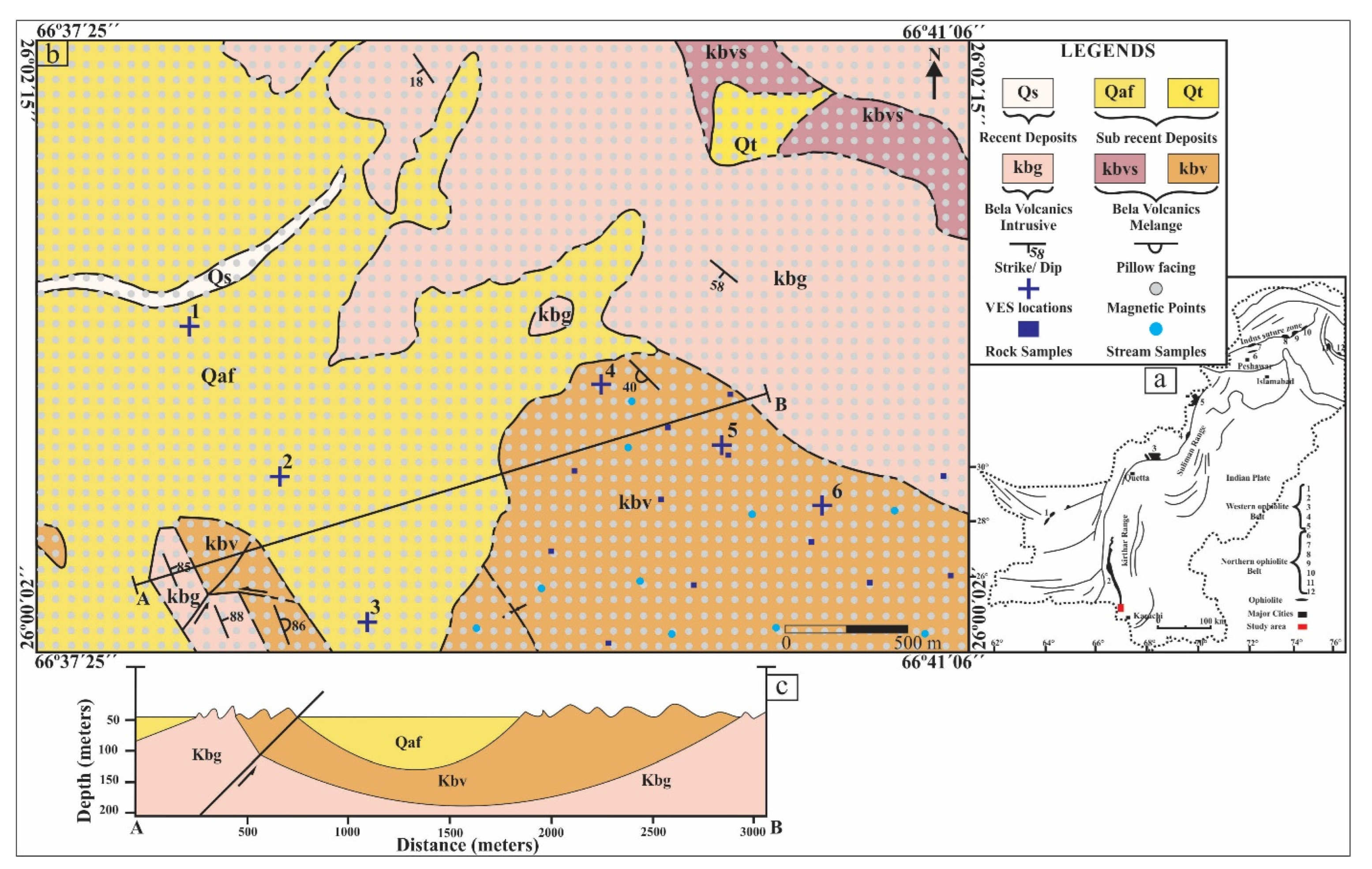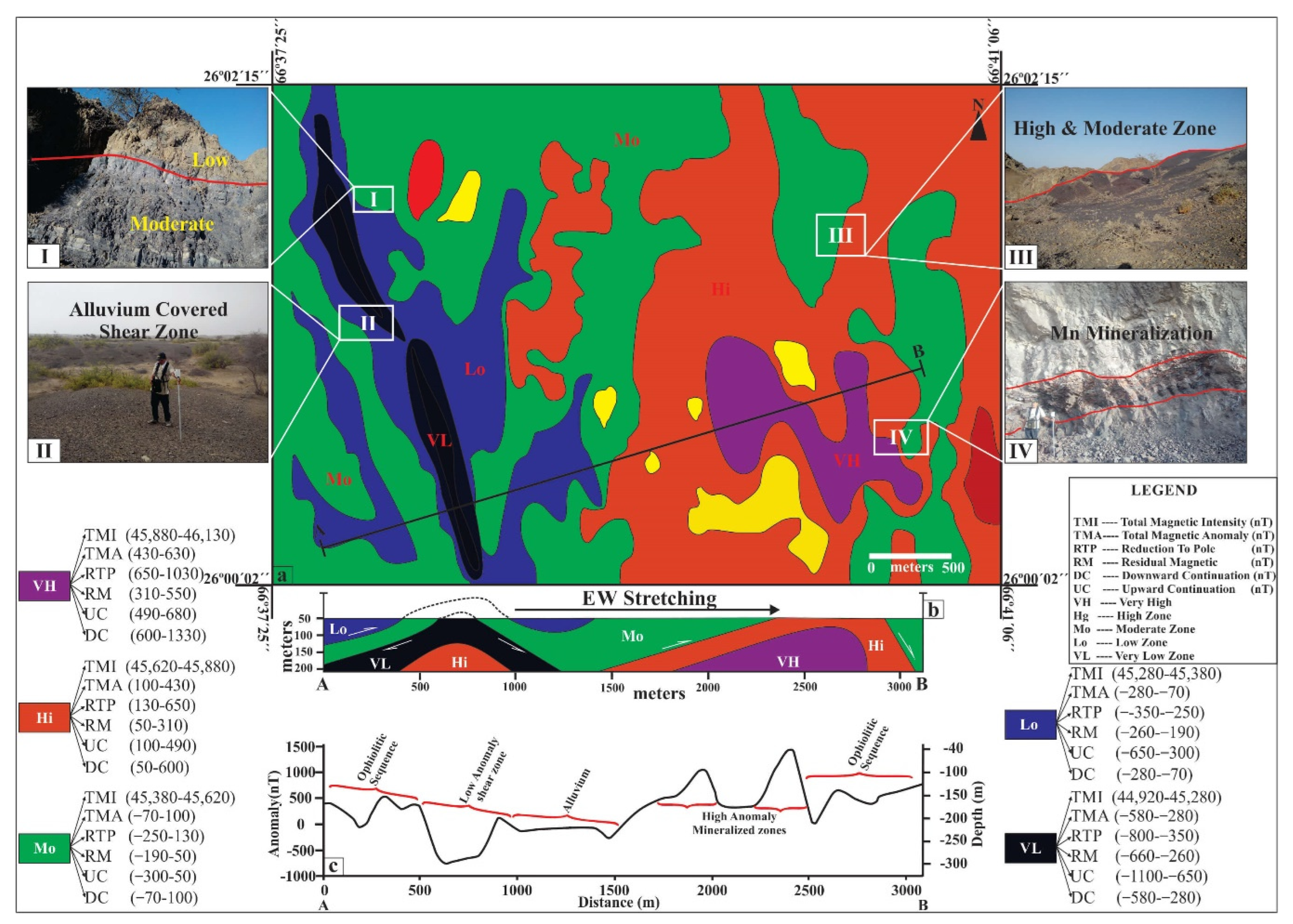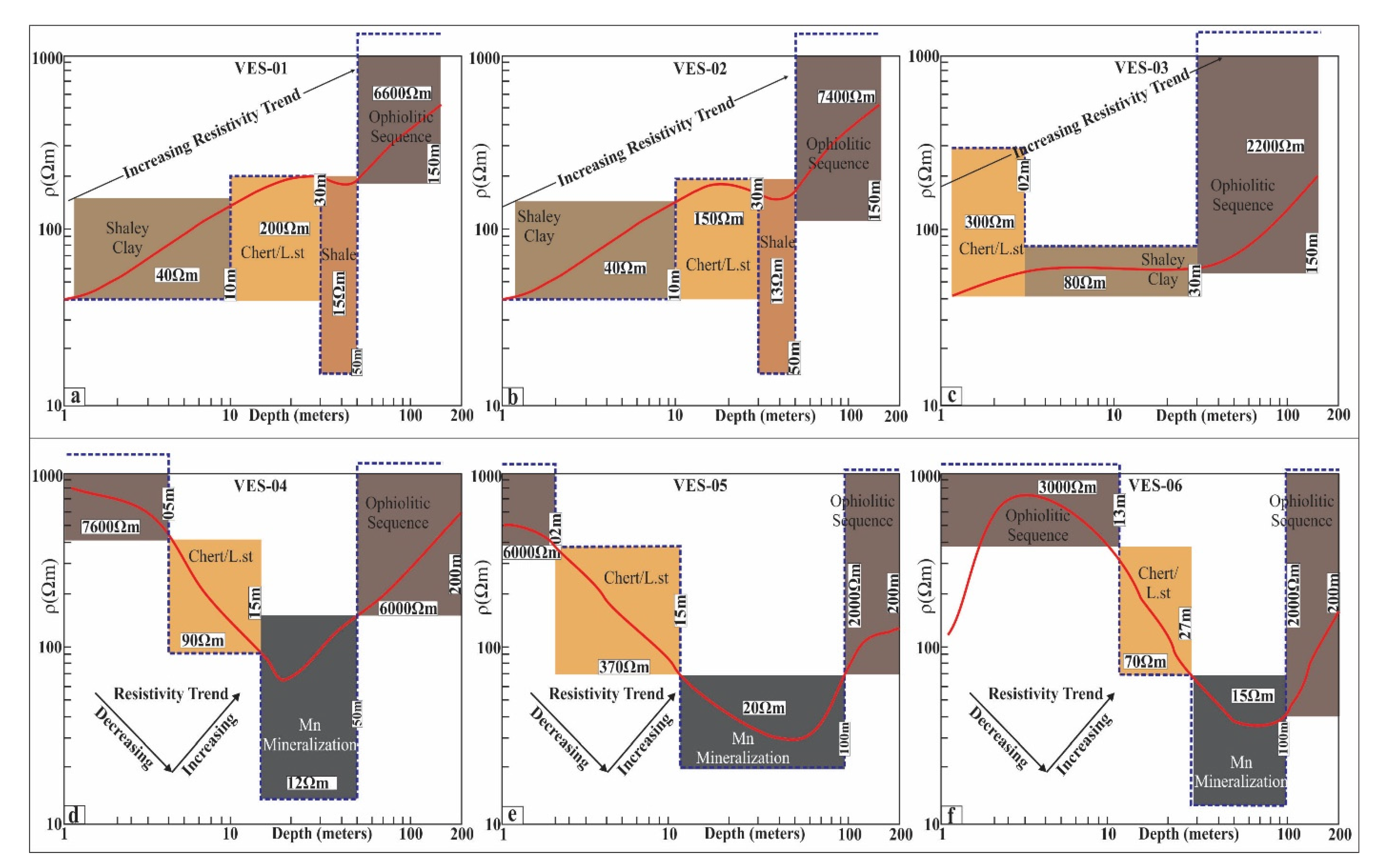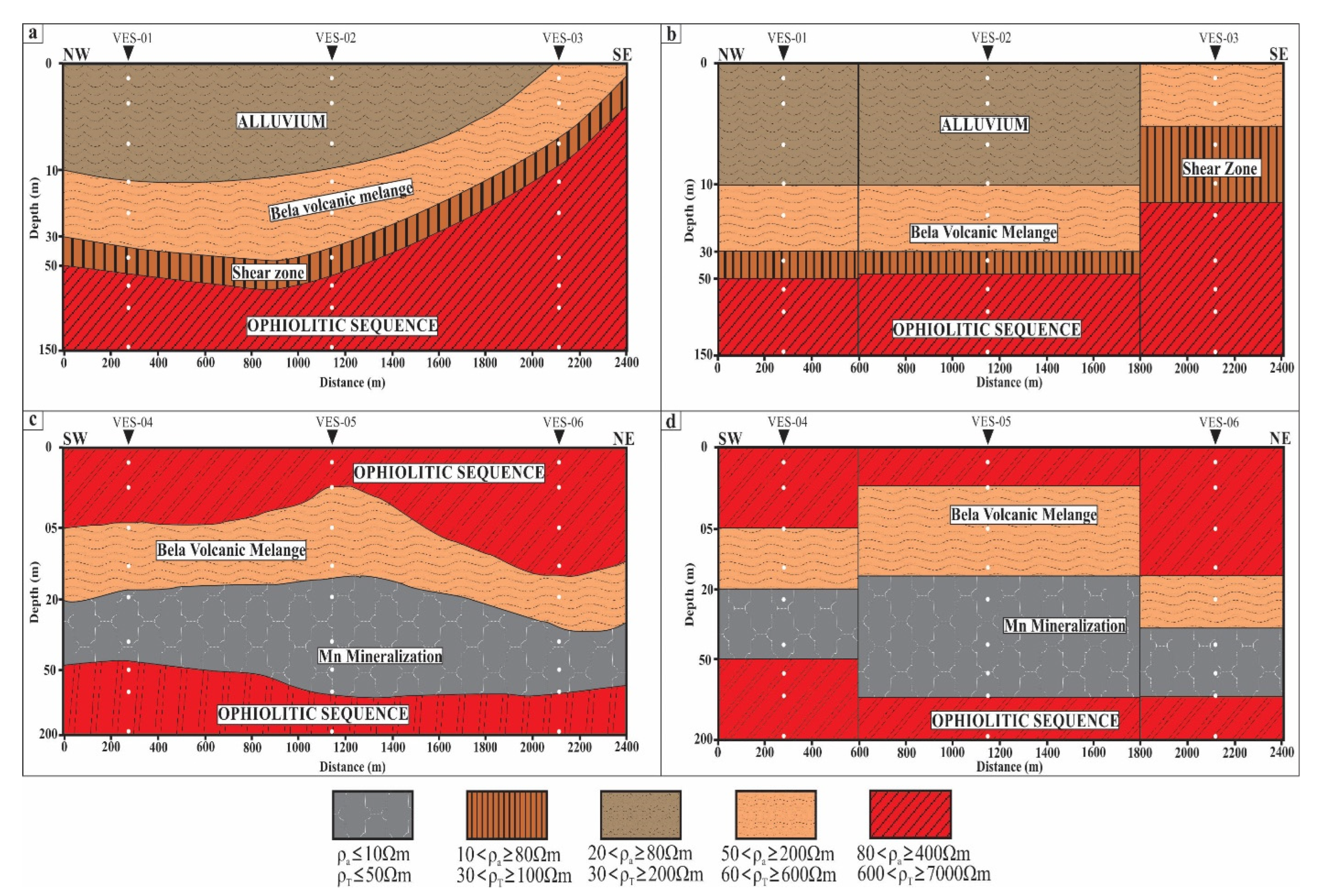Metallic-Mineral Prospecting Using Integrated Geophysical and Geochemical Techniques: A Case Study from the Bela Ophiolitic Complex, Baluchistan, Pakistan
Abstract
1. Introduction
2. Materials and Methods
2.1. Magnetic Data Acquisition
Processing and Interpretation of Magnetic Data
2.2. Resistivity/IP Survey
2.3. Geochemical Analysis
3. Results
3.1. Magnetic
3.1.1. Upward Continuation (UC) and Downward Continuation (DC) of Magnetic Data
3.1.2. Vertical Derivative (VD) Map
3.1.3. Horizontal Gradient (HG) Map
3.1.4. Overall Geomagnetic Map
3.1.5. Geomagnetic Section
3.1.6. Statistical Analysis
3.2. Qualitative Interpretation of Geoelectrical Data
3.3. Comparison of Resistivity and Magnetic Data
3.4. Geochemical Analysis
4. Analysis and Discussion
5. Conclusions
- In the SE part of the study area, a positive high-magnetic anomaly (A2) is observed, which shows the presence of an ultramafic sequence of BOC. Rocks that show paramagnetic response indicate manganese-ore deposits with a residual magnetic signature of 310–550 nT. In contrast, a negative magnetic anomaly (A1) is observed in the western part of the study area that ranges between −190 nT to 50 nT. This NW–SE trending low-anomalous zone is interpreted by RTP, TMI, HG, and RM as a shear zone covered by alluvium.
- Resistivity and IP surveys are conducted along the low-magnetic zone (A1) for any sulfide mineralization, and the resistivity values fluctuate between 10 Ωm to 80 Ωm, which shows the presence of clay minerals covered by alluvium to a depth of 50 m. The resistivity values gradually increase and reach a peak value of 4000 Ωm, confirming the presence of the ultramafic sequence at greater depths. The sulfide deposits are supposed to produce a low-resistivity signal with high chargeability; however, the IP values fluctuate between 0.7 mV/V and 4 mV/V. This low-anomalous zone contains clay minerals, confirming no sulfide mineralization, and are strongly supported by VES and magnetic data, so are interpreted as a shear zone.
- The high-magnetic-anomalous zone (A2) is interpreted as Mn mineralization supported by a high-magnetic value and a high IP signature of 3.5 mV/V to 15.1 mV/V.
- The geochemical analysis along the high-magnetic zone verifies a very good deposit of Mn minerals, with a percentage composition of 36.5% for rock samples and 48,400 ppm, along with stream analysis.
- The statistical analysis demarcates the magnetic anomalous base value of 46,181 nT to 46,628 nT of total intensity and 783 nT to 1183 nT, which is used for the determination of Mn mineralization elsewhere along the BOC.
- The horizontal-filter map shows a series of concealed faults, by applying a horizontal linear filter covered by alluvium with major orientations in the NW–SE and N–S directions, indicating that the BOC has thrust upwards in the NW direction over Late Tertiary sediments associated with melange, represented by chaotic-mineral assemblage that is revealed by the geomagnetic section (A-B).
- Structurally, the study area is highly disturbed and a series of faults are formed, showing the tectonic forces in the E–W direction and the presence of horst and graben structures in the form of the shear zone, developed under the extensional regime and inferred from the geomagnetic section (A-B).
- The geomagnetic maps reveal that the Bela melange of the moderate magnetic signature accommodating Mn mineralization along the anticlinal zone corresponds to high-magnetic imprints other than Bela melange. While the Bela volcanic intrusive corresponds to a low-magnetic value compared to the mélange, which is characterized by alteration of the volcanic intrusive.
- The outcomes of this study could be fruitful for prioritizing zones of the prospect area to delineate lineaments and target zones that are of vital interest to the minerals sector of Pakistan.
Author Contributions
Funding
Data Availability Statement
Acknowledgments
Conflicts of Interest
References
- Yao, J.; Cawood, P.A.; Zhao, G.; Han, Y.; Xia, X.; Liu, Q.; Wang, P. Mariana-type ophiolites constrain the establishment of modern plate tectonic regime during Gondwana assembly. Nat. Commun. 2021, 12, 4189. [Google Scholar] [CrossRef] [PubMed]
- Sotiriou, P.; Polat, A. Comparisons between Tethyan Anorthosite-Bearing Ophiolites and Archean Anorthosite-Bearing Layered Intrusions: Implications for Archean Geodynamic Processes. Tectonics 2020, 39, e2020TC006096. [Google Scholar] [CrossRef]
- Wang, G.; Zhang, P. A New Understanding on the Emplacement of Ophiolitic Mélanges and Its Tectonic Significance: Insights from the Structural Analysis of the Remnant Oceanic Basin-Type Ophiolitic Mélanges. Acta Geol. Sin. Engl. Ed. 2020, 94, 60–62. [Google Scholar] [CrossRef]
- Zhang, P.F.; Zhou, M.F.; Yumul, G.P., Jr.; Wang, C.Y. Geodynamic setting of high-Cr chromite mineralization in nascent subduction zones: Li isotopic and REE constraints from the Zambales ophiolite, Philippines. Lithos 2021, 384, 105975. [Google Scholar] [CrossRef]
- Karimzadeh, H.; Rahgoshay, M.; Monsef, I. Mineralogy, Geochemistry, and Petrogenesis of Mantle Peridotites of Nehbandan Ophiolitic Complex, East of Iran. J. Econ. Geol. 2020, 12, 157–176. [Google Scholar]
- Kiseleva, O.N.; Airiyants, E.V.; Belyanin, D.K.; Zhmodik, S.M. Podiform chromitites and PGE mineralization in the Ulan-Sar’dag ophiolite (East Sayan, Russia). Minerals 2020, 10, 141. [Google Scholar] [CrossRef]
- Yang, J.; Wu, W.; Lian, D.; Rui, H. Peridotites, chromitites, and diamonds in ophiolites. Nat. Rev. Earth Environ. 2021, 2, 198–212. [Google Scholar] [CrossRef]
- Ullah, Z.; Shah, M.T.; Siddiqui, R.H.; Lian, D.-Y.; Khan, A.A. Petrochemistry of High-Cr and High-Al chromitites occurrences of Dargai Complex along Indus Suture Zone, Northern Pakistan. Episodes 2020, 43, 689–709. [Google Scholar] [CrossRef]
- Zaccarini, F.; Ifandi, E.; Tsikouras, B.; Grammatikopolous, T.; Garuti, G.; Mauro, D.; Bindi, L.; Stanley, C. Occurrence of new phosphides and sulfides of Ni, Co, V, and Mo from chromitite of the Othrys ophiolite complex (Central Greece). Per. Ital. Mineral 2019, 88, 29–43. [Google Scholar] [CrossRef]
- Uysal, I.; Akmaz, R.M.; Saka, S.; Kapsiotis, A. Coexistence of compositionally heterogeneous chromitites in the Antalya–Isparta ophiolitic suite, SW Turkey: A record of sequential magmatic processes in the sub-arc lithospheric mantle. Lithos 2016, 248, 160–174. [Google Scholar] [CrossRef]
- Bashir, E.; Naseem, S.; Kaleem, M.; Khan, Y.; Hamza, S. Study of Serpentinized Ultramafic Rocks of Bela Ophiolite, Balochistan, Pakistan. J. Geogr. Geol. 2012, 4, 79. [Google Scholar] [CrossRef]
- Zaigham, N.A.; Mallick, K.A. Bela ophiolite zone of southern Pakistan: Tectonic setting and associated mineral deposits. GSA Bull. 2000, 112, 478–489. [Google Scholar] [CrossRef]
- Sarwar, G. Tectonic setting of the Bela Ophiolites, southern Pakistan. Tectonophysics 1992, 207, 359–381. [Google Scholar] [CrossRef]
- Xiong, Y.; Khan, S.D.; Mahmood, K.; Sisson, V.B. Lithological mapping of Bela ophiolite with remote-sensing data. Int. J. Remote Sens. 2011, 32, 4641–4658. [Google Scholar] [CrossRef]
- Gnos, E.; Khan, A.S.; Mahmood, K.; Villa, I.M. Bela oceanic lithosphere assemblage and its relation to the Réunion hotspot. Terra Nova 1998, 10, 90–95. [Google Scholar] [CrossRef]
- Naseem, S.; Sheikh, S. Lithogeochemical Prospecting Through Stream Sediments in Bela Ophiolite of Lasbela Area. J. King Abdulaziz Univ. Sci. 1994, 7, 125–142. [Google Scholar] [CrossRef]
- Ahsan, S.N.; Quraishi, I.H. Mineral-Rock Resources of Lasbela and Khuzdar Districts, Balochistan, Pakistan. J. Himal. Earth Sci. 1997, 30, 41–51. [Google Scholar]
- Ali, S.I. A study of manganese ore deposits, Las Bela, West Pakistan. Acta Miner petrogr Szeged. 1971, 1, 141–148. [Google Scholar]
- Naseem, S.; Sheikh, S.A.; Qadeeruddin, M. Biogeochemical study of Tamarix aphylla from Lasbela area and its application in prospecting of ore deposits. Chin. J. Geochem. 1995, 14, 303–312. [Google Scholar] [CrossRef]
- Narejo, A.A.; Shar, A.M.; Fatima, N.; Sohail, K. Geochemistry and origin of Mn deposits in the Bela ophiolite complex, Balochistan, Pakistan. J. Pet. Explor. Prod. Technol. 2019, 9, 2543–2554. [Google Scholar] [CrossRef]
- Shah, S.H.A. The ophiolite belts and suture traces in Pakistan. J. Himal. Earth Sci. 1984, 17, 113–117. [Google Scholar]
- Canada, P.I.O.M. Aeromagnetic Interpretation of Khuzdar Bela Region Balochistan Pakistan; Geological Survey of Pakistan: Ministry of Petroleum and Natural Resources & Govt of Canada, Photosur Inc: Montreal, QC, Canada, 1981. [Google Scholar]
- Abedi, M.; Gholami, A.; Norouzi, G.-H. A stable downward continuation of airborne magnetic data: A case study for mineral prospectivity mapping in Central Iran. Comput. Geosci. 2013, 52, 269–280. [Google Scholar] [CrossRef]
- Kang, G.; Gao, G.; Bai, C.; Shao, D.; Feng, L. Characteristics of the crustal magnetic anomaly and regional tectonics in the Qinghai-Tibet Plateau and the adjacent areas. Sci. China Earth Sci. 2011, 55, 1028–1036. [Google Scholar] [CrossRef]
- Liang, R.; Pei, Y.; Zheng, Y.; Wei, J.; Liu, Y. Gravity and magnetic field and tectonic structure character in the southern Yellow Sea. Chin. Sci. Bull. 2003, 48, 64–73. [Google Scholar] [CrossRef]
- Rybakov, M.; Goldshmidt, V.; Hall, J.; Ben-Avraham, Z.; Lazar, M. New insights into the sources of magnetic anomalies in the Levant. Russ. Geol. Geophys. 2011, 52, 377–397. [Google Scholar] [CrossRef]
- Quesnel, Y.; Weckmann, U.; Ritter, O.; Stankiewicz, J.; Lesur, V.; Mandea, M.; Langlais, B.; Sotin, C.; Galdéano, A. Simple models for the Beattie Magnetic Anomaly in South Africa. Tectonophysics 2009, 478, 111–118. [Google Scholar] [CrossRef]
- Yatini, Y.; Zakaria, M.F.; Suyanto, I. Identification of Gold Mineralization Zones Using Magnetic Data at Gunung Gupit Area, Magelang, Central Java. In RSF Conference Series: Engineering and Technology; Research Synergy Foundation Press: Bandung, Indonesia, 2021; Volume 1, pp. 305–312. [Google Scholar] [CrossRef]
- Ewusi, A.; Adatsi, E.; Seidu, J. Integrated geophysical study to delineate mineralized zones in southwest Ashanti Belt of Ghana. J. Geosci. Environ. Prot. 2018, 6, 77. [Google Scholar]
- Hasan, M.; Shang, Y.; Jin, W. Delineation of weathered/fracture zones for aquifer potential using an integrated geophysical approach: A case study from South China. J. Appl. Geophys. 2018, 157, 47–60. [Google Scholar] [CrossRef]
- Araffa, S.A.S.; Santos, F.A.M.; Arafa-Hamed, T. Delineating active faults by using integrated geophysical data at northeastern part of Cairo, Egypt. NRIAG J. Astron. Geophys. 2012, 1, 33–44. [Google Scholar] [CrossRef][Green Version]
- Milsom, J. Field Geophysics; John Wiley and Sons Ltd: Chichester, UK, 2007. [Google Scholar]
- Tchokpon, K.G.; Kaki, C.; Kourouma, M.; Yalo, N. Detection of gold-bearing quartz veins in the meta-sedimentary formation in the North-Eastern Guinea using remote sensing and geophysical exploration. J. Afr. Earth Sci. 2020, 168, 103869. [Google Scholar] [CrossRef]
- Naskar, D.C.; Kulkarni, A.V.; Lakshmana, M. Geophysical investigation for base metal mineralization in Karoi-Rajpura area, Bhilwara district, Rajasthan. J. Ind. Geophys. Union 2018, 22, 379–388. [Google Scholar]
- Riddihough, R.P. Diurnal Corrections to Magnetic Surveys-an Assessment of Errors. Geophys. Prospect. 1971, 19, 551–567. [Google Scholar] [CrossRef]
- Bloxham, J.; Gubbins, D.; Jackson, A. Geomagnetic secular variation. Philosophical Transactions of the Royal Society of London. Ser. A Math. Phys. Sci. 1989, 329, 415–502. [Google Scholar]
- Mahboubian, F.; Sardari, H.; Sadeghi, S.; Sarreshtedari, F. Design and Implementation of a Low Noise Earth Field Proton Precession Magnetometer. In Proceedings of the 2019 27th Iranian Conference on Electrical Engineering (ICEE), Yazd, Iran, 30 April–2 May 2019; pp. 345–347. [Google Scholar]
- Fedi, M.; Florio, G.; Rapolla, A. A method to estimate the total magnetization direction from a distortion analysis of magnetic anomalies1. Geophys. Prospect. 1994, 42, 261–274. [Google Scholar] [CrossRef]
- Foss, C. Magnetic Data Enhancements and Depth Estimation. In Encyclopedia of Solid Earth Geophysics; Gupta, H.K., Ed.; Springer International Publishing: Cham, Switzerland, 2020. [Google Scholar] [CrossRef]
- Azad, M. Application of Upward Continuation Filter in the interpretation of Magnetic Data with the determination of Optimum Height Continuation, Mansoorabad Area of Yazd, Iran. J. Earth Space Phys. 2015, 41, 229–238. [Google Scholar]
- Hinze, W.J.; Von Frese, R.R.; Von Frese, R.; Saad, A.H. Gravity and Magnetic Exploration: Principles, Practices, and Applications; Cambridge University Press: Cambridge, UK, 2013. [Google Scholar]
- Cooper, G. The downward continuation of aeromagnetic data from magnetic source ensembles. Near Surf. Geophys. 2019, 17, 101–107. [Google Scholar] [CrossRef]
- Cooper, G.R.J.; Cowan, D.R. Filtering using variable order vertical derivatives. Comput. Geosci. 2004, 30, 455–459. [Google Scholar] [CrossRef]
- Stanley, J.M. Simplified Magnetic Interpretation of the Geologic Contact and Thin Dike. Geophysics 1977, 42, 1236–1240. [Google Scholar] [CrossRef]
- El All, E.A.; Khalil, A.; Rabeh, T.; Osman, S. Geophysical contribution to evaluate the subsurface structural setting using magnetic and geothermal data in El-Bahariya Oasis, Western Desert, Egypt. NRIAG J. Astron. Geophys. 2015, 4, 236–248. [Google Scholar] [CrossRef]
- Reid, A.B.; Allsop, J.M.; Granser, H.; Millett, A.J.; Somerton, I.W. Magnetic interpretation in three dimensions using Euler deconvolution. Geophysics 1990, 55, 80–91. [Google Scholar] [CrossRef]
- Thompson, D.T. EULDPH: A new technique for making computer-assisted depth estimates from magnetic data. Geophysics 1982, 47, 31–37. [Google Scholar] [CrossRef]
- Stavrev, P.; Reid, A. Degrees of homogeneity of potential fields and structural indices of Euler deconvolution. Geophysics 2007, 72, L1–L12. [Google Scholar] [CrossRef]
- Stavrev, P.; Reid, A. Euler deconvolution of gravity anomalies from thick contact/fault structures with extended negative structural index. Geophysics 2010, 75, I51–I58. [Google Scholar] [CrossRef]
- El-Makky, A.M.; Sediek, K.N. Stream Sediments Geochemical Exploration in the Northwestern Part of Wadi Allaqi Area, South Eastern Desert, Egypt. Nonrenewable Resour. 2012, 21, 95–115. [Google Scholar] [CrossRef]
- Ravisankar, R.; Tholkappian, M.; Chandrasekaran, A.; Eswaran, P.; El-Taher, A. Effects of physicochemical properties on heavy metal, magnetic susceptibility and natural radionuclides with statistical approach in the Chennai coastal sediment of east coast of Tamilnadu, India. Appl. Water Sci. 2019, 9, 151. [Google Scholar] [CrossRef]
- Soupios, P.M.; Kouli, M.; Vallianatos, F.; Vafidis, A.; Stavroulakis, G. Estimation of aquifer hydraulic parameters from surficial geophysical methods: A case study of Keritis Basin in Chania (Crete–Greece). J. Hydrol. 2007, 338, 122–131. [Google Scholar] [CrossRef]
- Bobachev, C. IPI2Win: A Windows Software for an Automatic Interpretation of Resistivity Sounding Data; Moscow State University: Moscow, Russia, 2002; Volume 320. [Google Scholar]
- Daneshvar Saein, L.; Rasa, I.; Rashidnejad Omran, N.; Moarefvand, P.; Afzal, P. Application of the concentration-volume fractal method in induced polarization and resistivity data interpretation for Cu-Mo porphyry deposits exploration, case study: Nowchun Cu-Mo deposit, SE Iran. Nonlinear Processes Geophys. 2012, 19, 431–438. [Google Scholar] [CrossRef]
- Hördt, A.; Hanstein, T.; Hönig, M.; Neubauer, F.M. Efficient spectral IP-modelling in the time domain. J. Appl. Geophys. 2006, 59, 152–161. [Google Scholar] [CrossRef]
- Seigel, H.O.; Vanhala, H.; Sheard, S.N. Some case histories of source discrimination using time-domain spectral IP. Geophysics 1997, 62, 1394–1408. [Google Scholar] [CrossRef]
- Vieira, L.B.; Moreira, C.A.; Côrtes, A.R.P.; Luvizotto, G.L. Geophysical modeling of the manganese deposit for Induced Polarization method in Itapira (Brazil). Geofísica Int. 2016, 55, 107–117. [Google Scholar] [CrossRef]
- Ramazi, H.; Mostafaie, K. Application of integrated geoelectrical methods in Marand (Iran) manganese deposit exploration. Arab. J. Geosci. 2012, 6, 2961–2970. [Google Scholar] [CrossRef]
- Moreira, C.A.; Borges, M.R.; Vieira, G.M.L.; Filho, W.M.; Montanheiro, M.A.F. Geological and geophysical data integration for delimitation of mineralized areas in a supergene manganese deposits. Geofísica Int. 2014, 53, 199–210. [Google Scholar] [CrossRef]
- Taufan, Y.A.; Denis, M.; Nur, A.A.; Syafri, I. Manganese Prospect Identification Using Magnetic and Induced Polarization Methods. Bull. Sci. Contrib. Geol. 2018, 16, 215–220. [Google Scholar]
- Kwan, K.; Müller, D. Mount Milligan alkalic porphyry Au--Cu deposit, British Columbia, Canada, and its AEM and AIP signatures: Implications for mineral exploration in covered terrains. J. Appl. Geophys. 2020, 180, 104131. [Google Scholar] [CrossRef]
- Dusabemariya, C.; Qian, W.; Bagaragaza, R.; Faruwa, A.R.; Ali, M. Some Experiences of Resistivity and Induced Polarization Methods on the Exploration of Sulfide: A Review. J. Geosci. Environ. Prot. 2020, 8, 68–92. [Google Scholar] [CrossRef]
- Kumar, P.; Tiwari, P.; Singh, A.; Biswas, A.; Acharya, T. Electrical Resistivity and Induced Polarization signatures to delineate the near-surface aquifers contaminated with seawater invasion in Digha, West-Bengal, India. CATENA 2021, 207, 105596. [Google Scholar] [CrossRef]








| A1 | A2 | |||||
|---|---|---|---|---|---|---|
| Depth (m) | VES-01 | VES-02 | VES-03 | VES-04 | VES-05 | VES-06 |
| 10 | 1 | 0.78 | 1.78 | 4.1 | 3.5 | 4.7 |
| 15 | 1.5 | 1.06 | 2.23 | 8.2 | 9.1 | 10 |
| 20 | 1.5 | 1.34 | 2.47 | 13 | 12.1 | 14.7 |
| 30 | 1.99 | 1.72 | 2.35 | 13.5 | 14.5 | 15.1 |
| 30 | 1.99 | 1.72 | 2.35 | 12.2 | 13.7 | 14.2 |
| 40 | 2.05 | 2 | 2.99 | 11.3 | 12.9 | 12.7 |
| 60 | 1.99 | 2.47 | 2.91 | 10.9 | 14.8 | 15.1 |
| 80 | 2.02 | 2.8 | 3.04 | 14.8 | 14.3 | 13.9 |
| 100 | 2.23 | 3.73 | 3.25 | 10.7 | 9.4 | 9.3 |
| 150 | 2.34 | 4.01 | 3.18 | 9.1 | 8.7 | 8.4 |
| Rock Samples (in % Age) | |||||||||||||
|---|---|---|---|---|---|---|---|---|---|---|---|---|---|
| Elements | RB01 | RB02 | RB03 | RB04 | RB05 | RB06 | RB07 | RB08 | RB09 | RB10 | RB11 | RB12 | Average |
| MnO | 39.4 | 36.2 | 35.6 | 38.9 | 35.4 | 32.4 | 31.2 | 36.5 | 37.8 | 35.7 | 39.4 | 39.2 | 36.5 |
| Fe2O3 | 10.1 | 12.3 | 6.7 | 9.4 | 11.3 | 8.9 | 9.6 | 8.8 | 5.6 | 13.2 | 11.2 | 11.1 | 9.9 |
| Al2O3 | 0.9 | 1.5 | 1.7 | 0.28 | 1.6 | 0.8 | 0.7 | 1.1 | 0.6 | 1.8 | 0.6 | 0.23 | 1.0 |
| MgO | 1.2 | 0.83 | 0.9 | 0.65 | 0.54 | 0.89 | 1.3 | 1.8 | 1.6 | 0.73 | 1.2 | 0.45 | 1.0 |
| CaO | 0.4 | 1.7 | 0.9 | 0.5 | 1.5 | 2.3 | 1.89 | 1.4 | 0.75 | 0.63 | 0.45 | 1.2 | 1.1 |
| SiO2 | 44.7 | 45.3 | 48.7 | 45.9 | 46.8 | 49.4 | 50.3 | 46.5 | 49.8 | 41.4 | 42.7 | 43.1 | 46 |
| Na2O | 0.34 | 0.12 | 0.25 | 0.91 | 0.75 | 0.63 | 0.32 | 0.2 | 0.36 | 0.79 | 0.89 | 0.31 | 0.49 |
| k2O | 0.49 | 0.32 | 0.56 | 0.08 | 0.24 | 0.79 | 0.83 | 0.23 | 0.47 | 0.32 | 0.15 | 0.29 | 0.40 |
| P2O5 | 0.6 | 0.13 | 0.3 | 0.23 | 0.34 | 0.04 | 0.06 | 0.11 | 0.08 | 0.7 | 0.18 | 0.39 | 0.26 |
| TiO2 | 0.18 | 0.29 | 0.12 | 0.4 | 1.3 | 0.8 | 0.91 | 0.75 | 0.67 | 0.52 | 0.32 | 0.44 | 0.56 |
| LOI | 1.7 | 1.5 | 4.27 | 2.8 | 1.1 | 3.2 | 3.4 | 2.61 | 2.27 | 4.21 | 3.21 | 3.3 | 2.80 |
| Total | 100.0 | 100.2 | 100.0 | 100.1 | 100.9 | 100.2 | 100.5 | 100.0 | 100.0 | 100.0 | 100.3 | 100.0 | 100 |
Publisher’s Note: MDPI stays neutral with regard to jurisdictional claims in published maps and institutional affiliations. |
© 2022 by the authors. Licensee MDPI, Basel, Switzerland. This article is an open access article distributed under the terms and conditions of the Creative Commons Attribution (CC BY) license (https://creativecommons.org/licenses/by/4.0/).
Share and Cite
Rashid, M.U.; Ahmed, W.; Waseem, M.; Zamin, B.; Ahmad, M.; Sabri, M.M.S. Metallic-Mineral Prospecting Using Integrated Geophysical and Geochemical Techniques: A Case Study from the Bela Ophiolitic Complex, Baluchistan, Pakistan. Minerals 2022, 12, 825. https://doi.org/10.3390/min12070825
Rashid MU, Ahmed W, Waseem M, Zamin B, Ahmad M, Sabri MMS. Metallic-Mineral Prospecting Using Integrated Geophysical and Geochemical Techniques: A Case Study from the Bela Ophiolitic Complex, Baluchistan, Pakistan. Minerals. 2022; 12(7):825. https://doi.org/10.3390/min12070825
Chicago/Turabian StyleRashid, Mehboob Ur, Waqas Ahmed, Muhammad Waseem, Bakht Zamin, Mahmood Ahmad, and Mohanad Muayad Sabri Sabri. 2022. "Metallic-Mineral Prospecting Using Integrated Geophysical and Geochemical Techniques: A Case Study from the Bela Ophiolitic Complex, Baluchistan, Pakistan" Minerals 12, no. 7: 825. https://doi.org/10.3390/min12070825
APA StyleRashid, M. U., Ahmed, W., Waseem, M., Zamin, B., Ahmad, M., & Sabri, M. M. S. (2022). Metallic-Mineral Prospecting Using Integrated Geophysical and Geochemical Techniques: A Case Study from the Bela Ophiolitic Complex, Baluchistan, Pakistan. Minerals, 12(7), 825. https://doi.org/10.3390/min12070825






